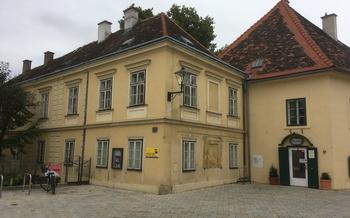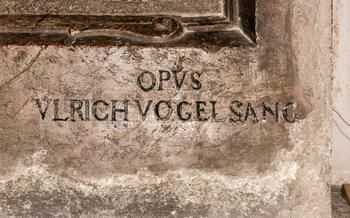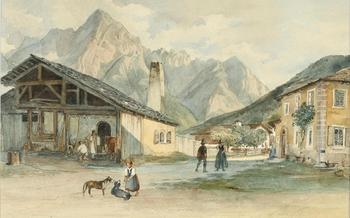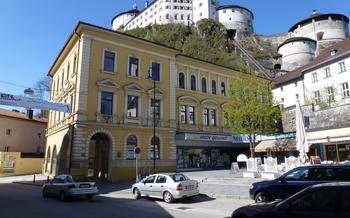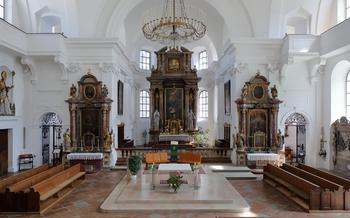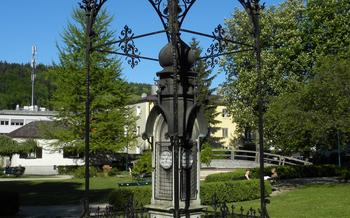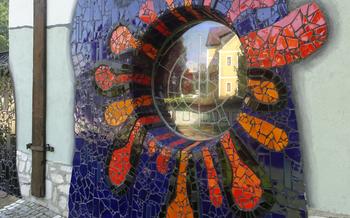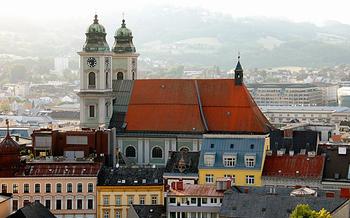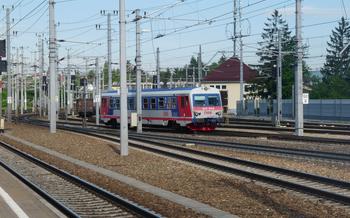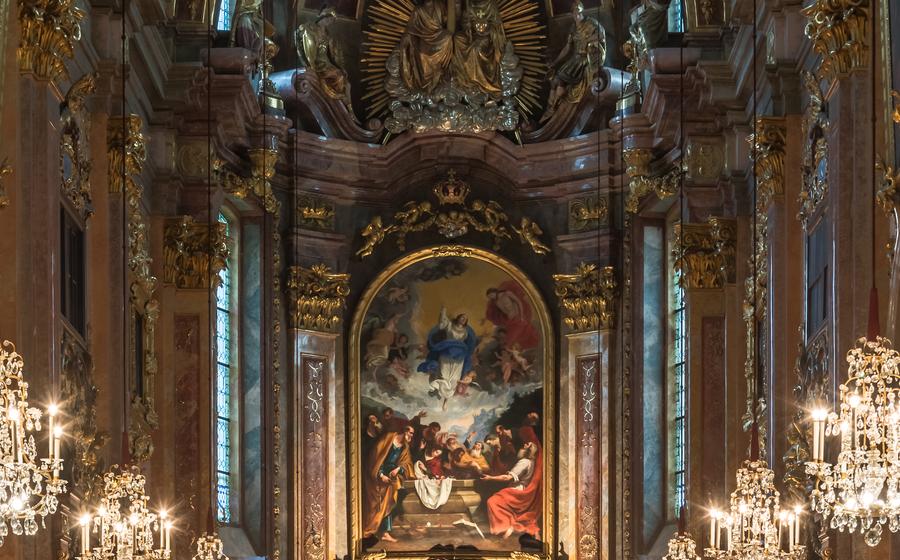
St. Pölten Cathedral (Dom zu St. Pölten)
- History of the St. Pölten Cathedral
- Architectural Highlights
- Stained Glass Windows
- Sculptures and Artwork
- Altars and Chapels
- Organ
- Bell Tower
- Crypts and Catacombs: A Journey Through History
- Guided Tours
- Accessibility
- Visitor Information
- Religious Services
- Pilgrimage Site
- Nearby Attractions
- Insider Tip: Unveiling the Secrets of St. Pölten Cathedral
History of the St. Pölten Cathedral
The St. Pölten Cathedral, also known as the Dom zu St. Pölten, holds a significant place in the history of the city and the surrounding region. The foundation stone for this magnificent structure was laid in 1150 by Bishop Reginbert von Hagenau, marking the beginning of its construction. The cathedral's initial design was influenced by the Romanesque style, prevalent at the time. However, over the centuries, it underwent several expansions and modifications, resulting in a blend of architectural styles, including Gothic and Baroque elements.
The cathedral's history is intertwined with numerous pivotal events. It served as the spiritual center of the Diocese of Passau until 1785, when it became the cathedral of the newly established Diocese of St. Pölten. Throughout its existence, the cathedral has witnessed countless religious ceremonies, solemn processions, and significant gatherings, leaving an indelible mark on the spiritual and cultural heritage of the region.
Architectural Highlights
The St. Pölten Cathedral stands as a testament to the architectural brilliance of its time. Its exterior is adorned with intricate carvings, sculptures, and reliefs that depict biblical scenes and religious figures. The two towering spires, reaching towards the heavens, create a striking silhouette against the cityscape. The cathedral's facade is a blend of Romanesque and Gothic styles, showcasing the transition between these architectural eras.
The interior of the cathedral is equally impressive, with its soaring nave, transepts, and chancel. The nave is supported by massive pillars that lead the eye towards the high altar. The transepts feature elaborate stained glass windows that bathe the interior in colorful light. The chancel, the most sacred part of the cathedral, is adorned with intricate carvings and decorative elements.
One unique feature of the cathedral is the pulpit, which is considered a masterpiece of Gothic art. Crafted from stone and adorned with intricate carvings, the pulpit depicts scenes from the life of Jesus Christ. The cathedral also boasts a stunning baptismal font, which is a popular spot for baptisms and other religious ceremonies.
The architectural grandeur of the St. Pölten Cathedral has served as an inspiration for numerous other buildings in the region. Many churches and public buildings in St. Pölten and the surrounding area exhibit similar architectural features, creating a cohesive cityscape that reflects the city's rich history and cultural heritage.
Stained Glass Windows
The St. Pölten Cathedral is renowned for its exquisite stained glass windows, which illuminate the interior with vibrant colors and intricate designs. Created by renowned artists and craftsmen, these windows depict biblical scenes, saints, and other religious motifs. The oldest surviving windows date back to the 14th century and showcase the Gothic style, characterized by their pointed arches and rich hues. Later additions from the Renaissance and Baroque periods feature more elaborate compositions and a wider range of colors.
One of the most striking windows is the "Last Judgment" window, located in the south transept. Created in the 15th century, it portrays the final judgment of humanity, with Christ depicted as the judge, surrounded by angels and saints. The window's intricate details and expressive figures are a testament to the skill of the medieval artisans who created it.
Another notable window is the "Tree of Jesse" window, located in the north aisle. Created in the 16th century, it depicts the lineage of Jesus Christ, with Jesse, the father of King David, shown as the root of the tree. The branches of the tree are filled with the figures of Christ's ancestors, each depicted with their unique attributes and symbols.
The stained glass windows of the St. Pölten Cathedral are not merely decorative elements but also serve as powerful tools for storytelling and religious instruction. They bring to life the Bible's narratives, inspire devotion, and contribute to the overall spiritual atmosphere of the sacred space.
Sculptures and Artwork
The St. Pölten Cathedral is adorned with a wealth of sculptures and artwork, each contributing to its spiritual and aesthetic splendor. Notable among these is the Pietà, a poignant sculpture depicting the Virgin Mary cradling the body of her crucified son, Jesus Christ. Crafted from Carrara marble, the Pietà showcases the artist's mastery in capturing the depth of emotion and sorrow in the figures.
Other notable sculptures include the Twelve Apostles, positioned along the nave's pillars, each representing a different apostle with unique attributes. The Stations of the Cross, a series of fourteen bas-relief sculptures, narrate the final journey of Jesus, from his condemnation to his crucifixion and resurrection. These intricate carvings offer a profound meditation on the sacrifice and redemption of Christ.
The cathedral also boasts a collection of paintings, many of which depict scenes from the Old and New Testaments. The Assumption of the Virgin Mary, a grand ceiling fresco, portrays the Virgin Mary being lifted into heaven by a host of angels. The Last Supper, a painting attributed to the Austrian artist Martin Johann Schmidt, captures the moment of betrayal as Judas Iscariot reaches for the bread, symbolizing his treachery.
These sculptures and artworks, with their exquisite craftsmanship and profound symbolism, enhance the spiritual and aesthetic experience of the cathedral, inviting visitors to contemplate the mysteries of faith and the life of Christ.
Altars and Chapels
At the heart of the St. Pölten Cathedral lies the awe-inspiring main altar, a masterpiece of Baroque artistry. Constructed from exquisite marble and adorned with intricate carvings, the altar is a testament to the skill and devotion of its creators. Its central focus is the tabernacle, a finely crafted receptacle where the consecrated Eucharistic bread is reserved. Elaborate sculptures and paintings depicting scenes from the life of Christ and the saints surround the tabernacle, inviting visitors to contemplate the sacred mysteries.
Beyond the main altar, the cathedral boasts a series of chapels, each with its own unique character and significance. The Chapel of St. John the Baptist, located in the southern transept, is adorned with stunning frescoes depicting the life of the saint. The Chapel of the Blessed Sacrament, situated in the northern transept, houses a beautiful stained glass window depicting the Last Supper. Other notable chapels include the Chapel of St. Joseph, the Chapel of St. Mary, and the Chapel of the Holy Cross, each adorned with distinctive artworks and relics.
These altars and chapels serve as focal points for the liturgical and devotional life of the cathedral. Throughout the year, they host a variety of religious services, including Mass, prayer services, and special events. Visitors are welcome to attend these services and experience the spiritual atmosphere of this sacred space.
Organ
The St. Pölten Cathedral is home to a magnificent organ, renowned for its exceptional size, tonal qualities, and historical significance. Built in the 18th century by renowned organ builder Franz Xaver Christoph, the instrument boasts an impressive 3,489 pipes, distributed across 49 stops and four manuals. The organ's rich and versatile sound has captivated audiences for centuries, making it a centerpiece of the cathedral's musical and liturgical traditions.
The organ's façade, adorned with intricate carvings and gilded ornamentation, is a testament to the craftsmanship and artistic vision of its creators. The instrument's size and grandeur are awe-inspiring, adding to the cathedral's already opulent ambiance. Over the years, the organ has been meticulously maintained and restored, ensuring that its exceptional sound and historical integrity are preserved for future generations.
Notable organists, including Franz Schmidt and Anton Bruckner, have performed on this magnificent instrument, leaving an indelible mark on the cathedral's musical heritage. The organ's versatility allows it to accompany both traditional and contemporary compositions, enhancing the spiritual and emotional impact of religious services, concerts, and recitals.
The St. Pölten Cathedral organ is not just a musical masterpiece but also a symbol of the city's rich cultural and religious heritage. Its presence within the cathedral's sacred space contributes to the profound and immersive experience that visitors and worshippers encounter.
Bell Tower
The cathedral's bell tower, known as the Domturm, is a prominent landmark in St. Pölten. It stands at a height of 73 meters and is divided into four sections. The lower section is Romanesque in style, while the upper three sections are Gothic. The tower houses six bells, including the largest bell in St. Pölten, which weighs over 4 tons. The bells are rung daily, filling the city with their melodious sounds. The tower also serves as a viewing platform, offering visitors panoramic views of St. Pölten and the surrounding countryside. To reach the viewing platform, visitors must climb 239 steps, but the effort is rewarded with breathtaking views.
Crypts and Catacombs: A Journey Through History
Beneath the grand facade of St. Pölten Cathedral lies a hidden world of history and mystery—the crypts and catacombs. These subterranean chambers have served as the final resting place for countless individuals throughout the centuries, offering a glimpse into the lives and legacies of those who have shaped the cathedral's rich tapestry.
The crypts, located beneath the chancel, are home to the remains of bishops, priests, and other prominent figures who have served the cathedral over the years. Elaborate tombs and epitaphs adorn the walls, each telling a unique story of faith, devotion, and service. Among the most notable burials is that of Bishop Johann Michael Leonhard, whose ornate sarcophagus stands as a testament to his contributions to the cathedral and the diocese.
Descending further into the depths of the cathedral, visitors can explore the catacombs, a labyrinth of tunnels and chambers that once served as a burial ground for the city's early Christian community. Here, visitors can witness the simple yet poignant graves of ordinary people—a stark reminder of the fragility of life and the enduring power of faith.
The crypts and catacombs of St. Pölten Cathedral offer a unique opportunity to delve into the history of the city and its people. They provide a glimpse into the lives of those who have gone before us, reminding us of the enduring legacy of the cathedral and its role in shaping the spiritual and cultural heritage of the region.
Guided Tours
Guided tours of the St. Pölten Cathedral are available for visitors who wish to delve deeper into its history, architecture, and religious significance. Knowledgeable and passionate guides lead these tours, providing insights into the cathedral's construction, unique features, and the stories behind its many artworks and artifacts.
The tours typically cover various aspects of the cathedral, including its architectural styles, the symbolism of its stained glass windows, the significance of its sculptures and artwork, and the history of its altars and chapels. Guides also share fascinating anecdotes and legends associated with the cathedral, bringing its rich heritage to life.
Visitors can choose from a variety of guided tours, depending on their interests and time constraints. Standard tours offer a comprehensive overview of the cathedral, while specialized tours focus on specific themes, such as its art and architecture, or its role as a pilgrimage site.
Reservations for guided tours can be made in advance through the cathedral's website or by contacting the cathedral office directly. Visitors can also join guided tours on a walk-up basis, subject to availability. The cathedral offers tours in multiple languages, including English, German, and Spanish, to accommodate international visitors.
By participating in a guided tour, visitors gain a deeper understanding and appreciation for the St. Pölten Cathedral and its profound cultural and spiritual significance.
Accessibility
The St. Pölten Cathedral is committed to ensuring that all visitors can enjoy and appreciate its beauty and spirituality. Accessibility features have been thoughtfully implemented throughout the cathedral to accommodate visitors with disabilities.
Visitors who require assistance can utilize the ramps and elevators to navigate the cathedral's interior. Audio guides are also available in multiple languages to provide a comprehensive and immersive experience for visitors with hearing impairments.
For those with visual impairments, tactile models of the cathedral's exterior and interior are available, allowing them to explore the architecture and artwork through touch.
The cathedral staff is dedicated to providing exceptional assistance to visitors with disabilities. They are happy to answer any questions, provide directions, or offer assistance to ensure a comfortable and enjoyable visit for everyone.
Visitors with disabilities are encouraged to contact the cathedral in advance to inquire about any specific accommodations or services they may require. With its commitment to accessibility, the St. Pölten Cathedral welcomes all visitors to embark on a journey of faith, art, and history.
Visitor Information
The St. Pölten Cathedral is located in the heart of the city, at Domplatz 1, 3100 St. Pölten, Austria. It is easily accessible by public transportation, with several bus stops nearby. Visitors can also reach the cathedral on foot from the city center, which is just a short walk away.
The cathedral is open to the public daily from 7:00 AM to 7:00 PM. Admission is free of charge, but donations are welcome. Visitors are encouraged to dress respectfully, as the cathedral is a sacred space.
Guided tours of the cathedral are available in English and German, and can be booked in advance or on-site. The tours typically last for about an hour and cover the history, architecture, and religious significance of the cathedral. Visitors can also explore the cathedral at their own pace using the audio guide, which is available in several languages.
For more information about the cathedral, visitors can visit the official website or call the information line at +43 2742 333 1The website provides detailed information about the cathedral's history, architecture, and religious significance, as well as information about guided tours, events, and accessibility.
Religious Services
The St. Pölten Cathedral serves as a vibrant spiritual center for the local community and visitors alike, offering a diverse range of religious services throughout the week. Masses: The heart of the cathedral's liturgical life is the celebration of Mass, which takes place daily, typically in the morning and evening. These services are open to all and provide an opportunity for prayer, reflection, and spiritual nourishment. Prayer Services: In addition to Masses, the cathedral hosts regular prayer services, including the Liturgy of the Hours, which is a traditional Christian prayer cycle observed at various times throughout the day. These services offer a contemplative atmosphere for personal devotion and communal worship. Special Events: The cathedral also hosts special religious events and celebrations throughout the year, attracting both local and international visitors. These events may include feast day celebrations, concerts, exhibitions, and pilgrimages, providing unique opportunities for spiritual enrichment and cultural exchange. For specific schedules and information on religious services and events, visitors are encouraged to check the cathedral's official website or inquire at the parish office.
Pilgrimage Site
The St. Pölten Cathedral holds a significant place as a pilgrimage site, attracting both local and international visitors seeking spiritual fulfillment and connection. The tradition of pilgrimage to the cathedral dates back centuries, with devout individuals undertaking journeys to seek blessings, offer prayers, and pay homage to the sacred relics associated with the cathedral.
One of the most notable pilgrimage events is the annual Domfest, held each year to celebrate the feast of the cathedral's patron saint, St. Hippolytus. During this festival, thousands of pilgrims gather to participate in processions, special masses, and other religious ceremonies. The Domfest is a vibrant and colorful celebration that showcases the rich spiritual heritage of the cathedral and the deep devotion of its followers.
Pilgrims also visit the cathedral throughout the year to venerate the various relics housed within its walls. These relics, believed to possess miraculous powers, include fragments of the True Cross, a piece of the veil of the Virgin Mary, and bones of various saints. Many pilgrims believe that touching or praying near these relics can bring healing, blessings, and spiritual guidance.
The cathedral's pilgrimage traditions continue to thrive in modern times, with visitors from all walks of life seeking solace, inspiration, and a deeper connection with their faith. Whether for spiritual renewal or historical exploration, the St. Pölten Cathedral remains a beacon of hope and devotion for pilgrims from around the world.
Nearby Attractions
After exploring the grandeur of St. Pölten Cathedral, visitors can embark on a journey to discover other captivating attractions in the city. A short walk from the cathedral, the Landhausviertel, the provincial government district, awaits with its stunning architecture and historical significance. The district houses the Landtag, the provincial parliament building, and the Regierungsgebäude, the seat of the provincial government. Visitors can admire the intricate facades and learn about the political history of the region.
St. Pölten also boasts a vibrant arts and culture scene, with several museums and theaters within easy reach of the cathedral. The Museum Niederösterreich, located in a former monastery, showcases a diverse collection of art, history, and natural history exhibits, providing insights into the region's rich heritage. The Festspielhaus St. Pölten, a modern theater and concert hall, hosts a wide range of performances, from classical concerts to contemporary theater productions.
For those seeking outdoor adventures, the nearby Viehofner Seenplatte, a chain of picturesque lakes, offers a tranquil retreat. Visitors can enjoy swimming, boating, and fishing in the serene waters, surrounded by lush greenery. The surrounding countryside is dotted with charming villages and vineyards, inviting visitors to explore the region's culinary delights and idyllic landscapes.
When planning a trip to St. Pölten, visitors can create a comprehensive itinerary that combines the sacred and the secular, the historical and the modern. By exploring the cathedral and its surroundings, they can immerse themselves in the city's rich tapestry of culture, history, and natural beauty, creating lasting memories of their visit.
Insider Tip: Unveiling the Secrets of St. Pölten Cathedral
As you wander through the grand halls of St. Pölten Cathedral, take a moment to step outside and explore the serene Kapitelplatz, the cathedral square. This hidden gem, often overlooked by visitors, offers a tranquil oasis amidst the city's vibrant energy. Admire the harmonious blend of architectural styles as you gaze upon the cathedral's imposing facade, the charming townhouses, and the picturesque fountain.
For an unforgettable experience, plan your visit to coincide with one of the cathedral's enchanting concerts. The acoustics within the sacred space are truly remarkable, transforming every note into a celestial symphony. Whether you're a classical music aficionado or simply seeking a moment of tranquility, these concerts are a feast for the senses.
St. Pölten Cathedral is more than just a religious landmark; it's a living testament to the city's rich history and cultural heritage. As you explore its hidden corners and immerse yourself in its sacred atmosphere, you'll discover a place where spirituality, art, and history intertwine, creating an experience that will stay with you long after your visit.
